"Have You Ever Even Been To A Farm?"
The pathetic attempts of dairy farmers and other animal exploiters to discredit activists.
Animal abusers who “farm” animals have a large arsenal of excuses, arguments, and propaganda tactics to appease their own consciousness as well as the consciousness of those who choose to support their evil practices. When informed people who truly care about animals speak the truth about what awfulness and injustice takes place in various animal ag industries farmers are always quick to deflect, discredit, dismiss, and debunk.
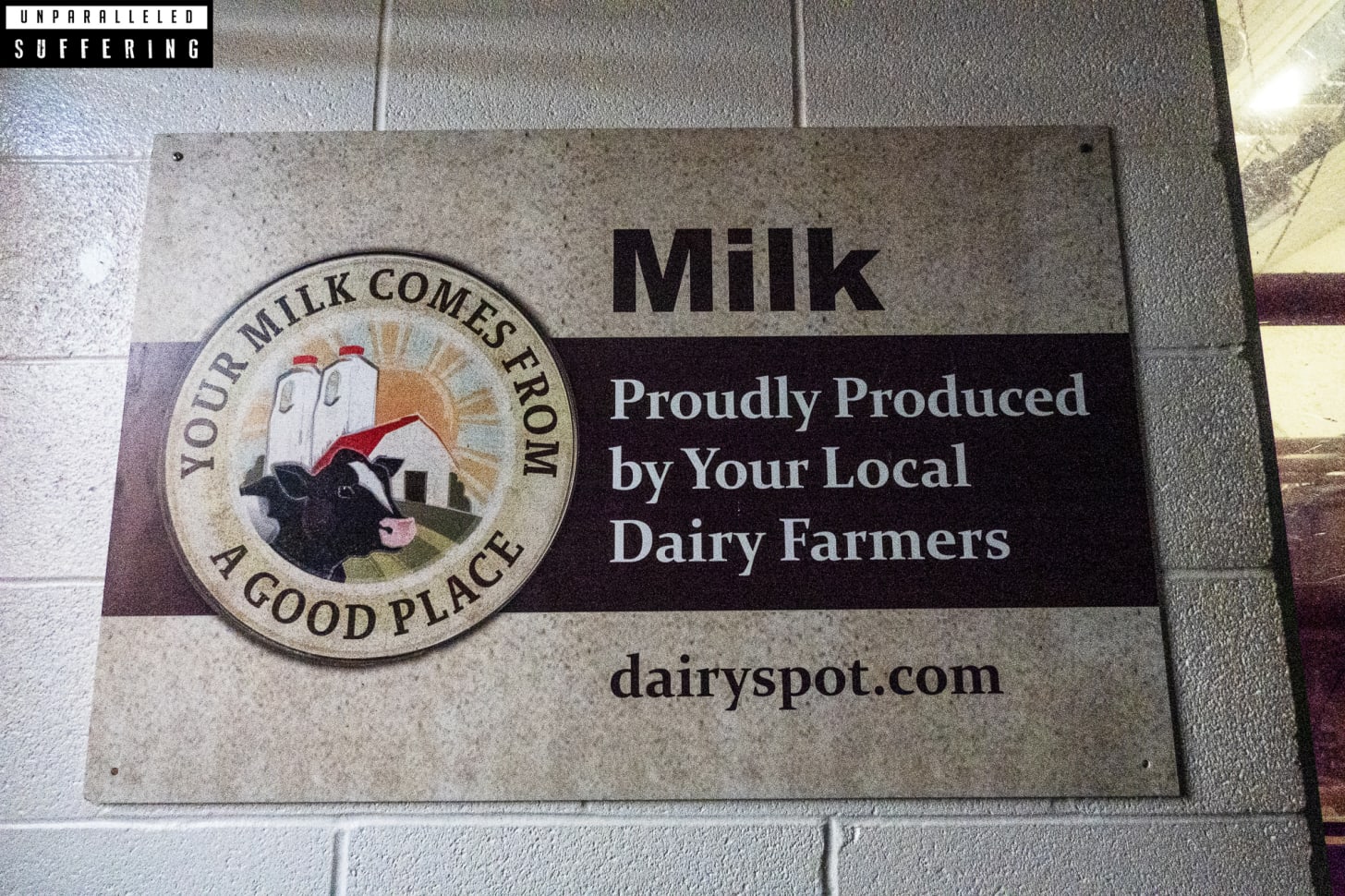
For example, as far as dismissing and debunking goes, if someone disapprovingly expresses how the calves are taken away from mother cows immediately after birth in the dairy industry a dairy farmer or someone else associated with the industry or animal agriculture in general may reply that no harm is committed within this practice since the mother lacks maternal instincts (since they’ve been “bred out” of her) so she doesn’t actually mind her baby being abducted, the baby is now safer (because mom could “injure or kill them”), and it’s also healthier for the calf since now they can be bottle fed colostrum (that they would have otherwise nursed naturally from their mother if given the chance).
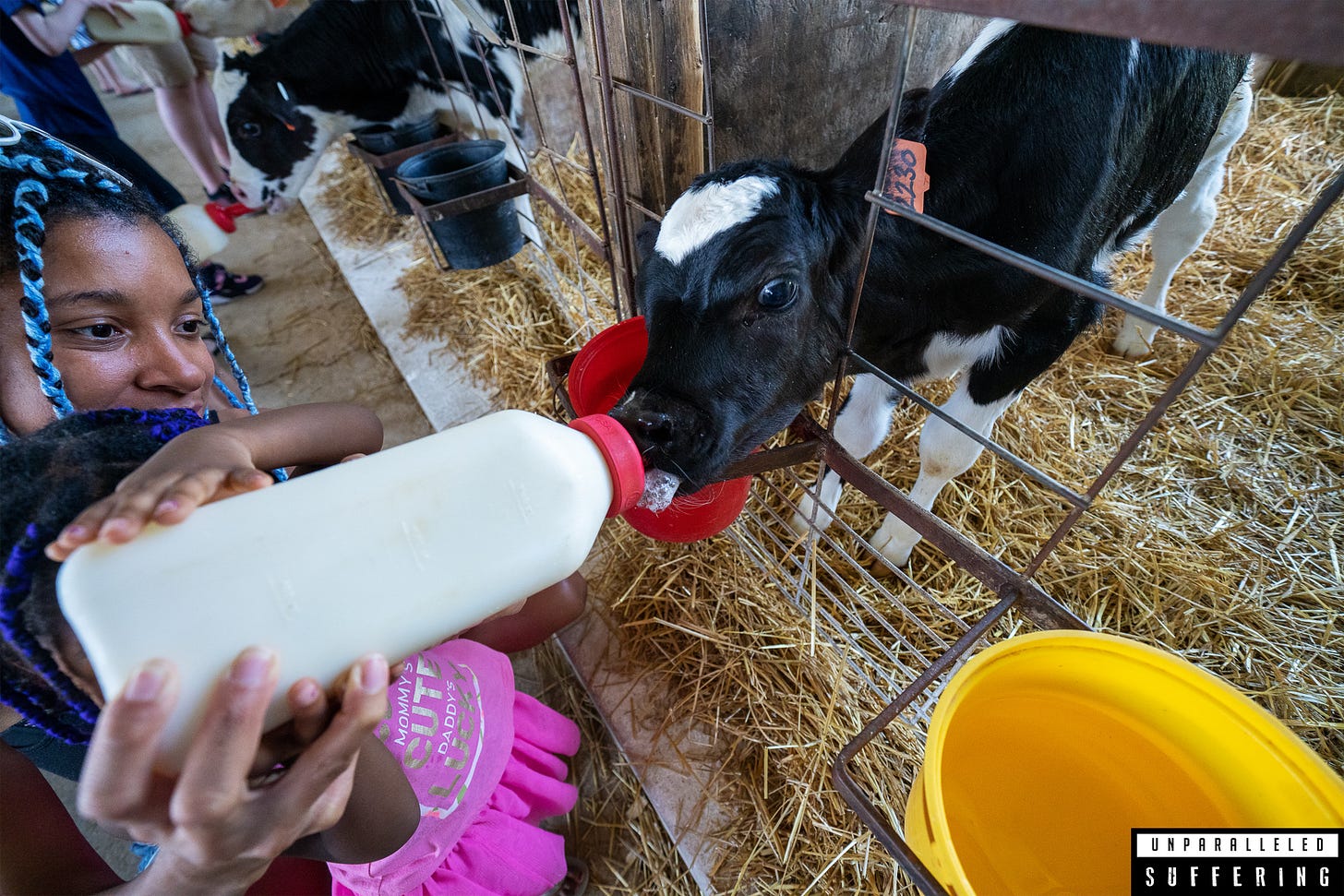
Well these claims by animal abusers are all lies and they know it. Honesty wouldn’t be good for marketing, although I don’t know if honesty would necessarily be bad for business. Lying is part of the gig just like so many other financial pursuits that aim to keep the public complacent, unaware, and unquestioning.
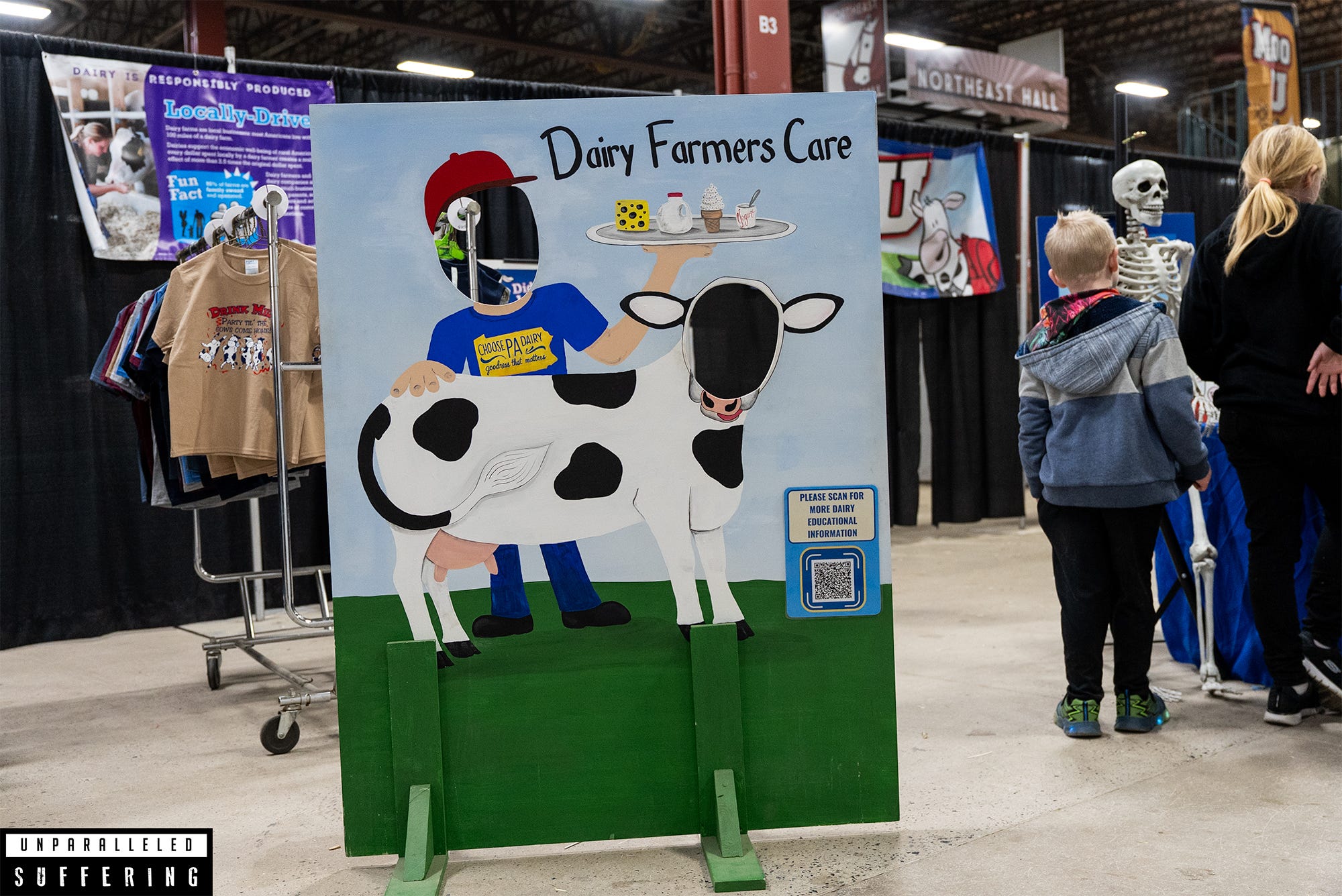
At this point I’ve watched at least 20-30 cows give birth in person and in all of the cases except for three that I witnessed on dairy farms, the babies were not taken away immediately after birth. The majority of births I’ve witnessed were in public settings such as fairs at “miracle of life” areas and also at the Fair Oaks Farms Birthing Center, an agtourism attraction in Indiana that glorifies industrial animal farming and serves products made with the notoriously ruthless Fairlife brand. Every time the babies remained with the mother after birth (usually for about 20-30 minutes) the mother took great care and interest in her baby; licking them up a storm, nuzzling them, standing and resting beside them—always remaining gentle, loving, and protective.
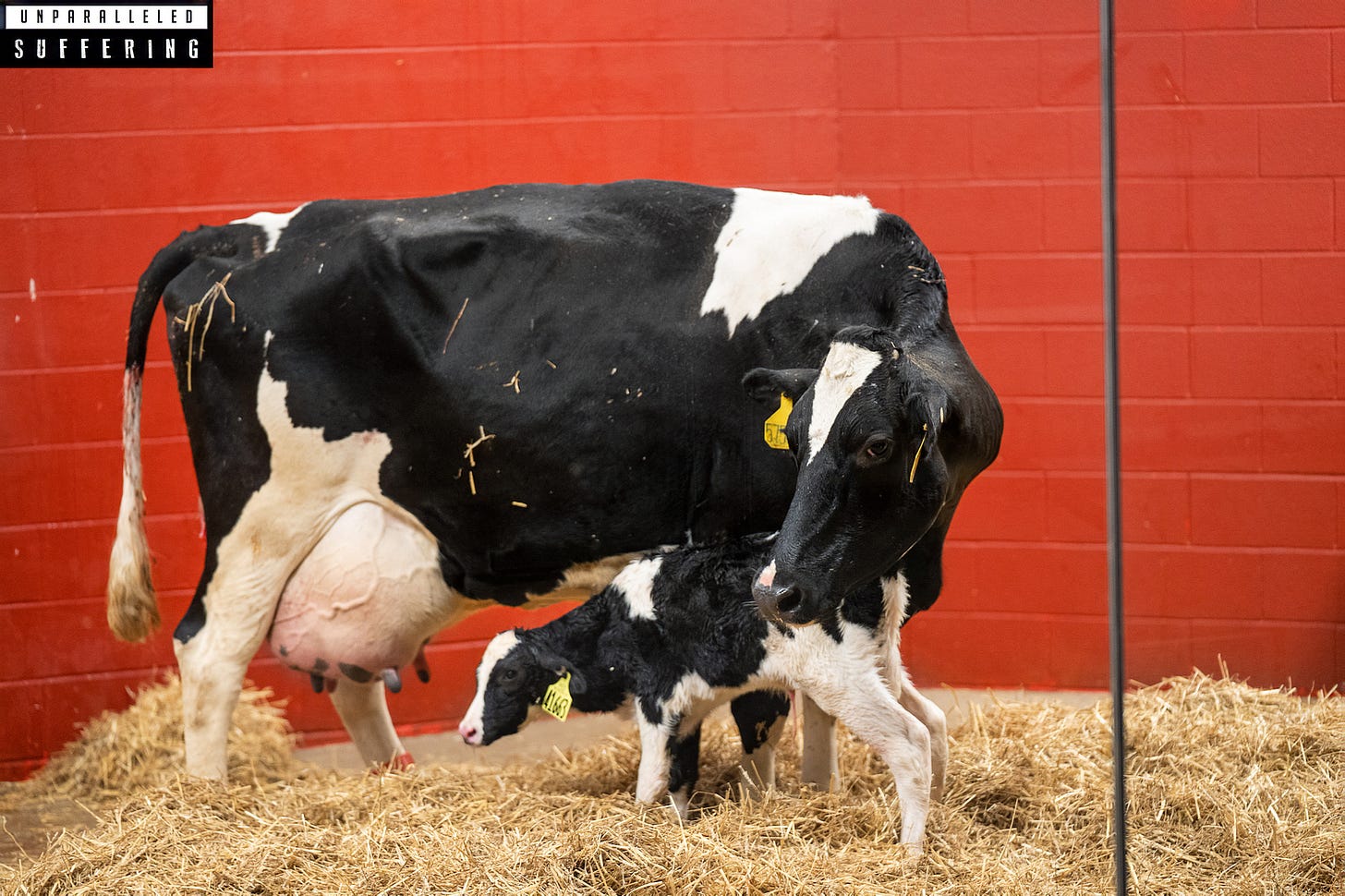
It would be poor optics and lousy entertainment for the general public to perform the norm—taking the baby away as immediately as possible after birth. Whenever a calf was removed from the cow at these public gatherings I never saw the cow or the calf unaffected or unfazed by the separation. With that being said, at the public births I never witnessed a cow go absolutely mad and attempt to break through the gates or anything like that. But there is a reason for this…
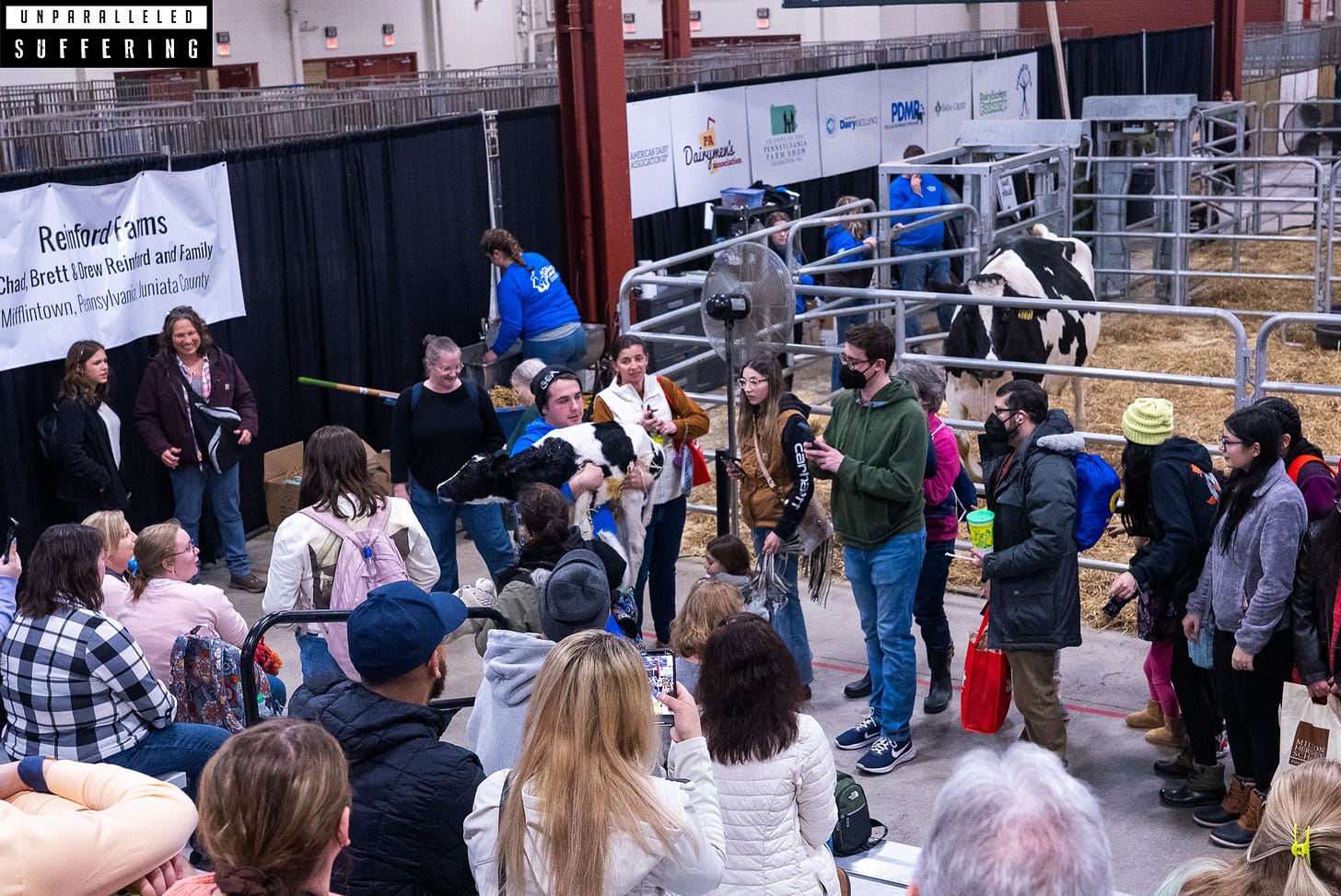
The cows used for the public birthing (calving as the industry calls it) displays have all previously given birth on a farm and remember the deal—that their nine-month-long pregnancy will lead to another baby that is somehow not theirs to keep. Given that they already have reasoned expectations of their baby being stolen, not only because they’ve already experienced it but also because they’ve witnessed it happening to other cows in their maternity pens, they don’t freak out in the same ways they do during the first go. This helps sell the narrative to the watching, smiling, and milkshake-consuming public that the mother cows don’t mind their babies being taken away.
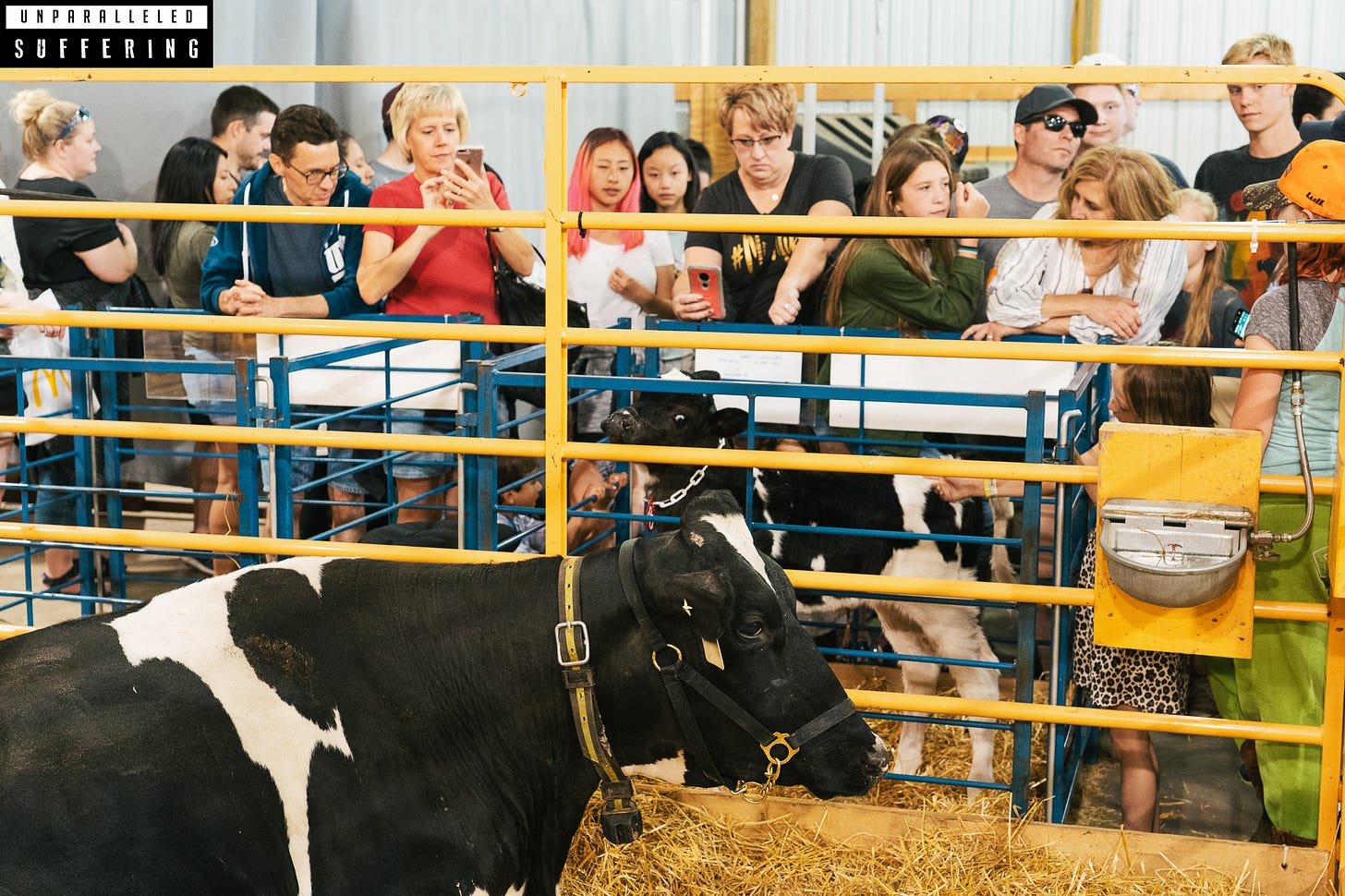
The last live birth I witnessed on a dairy farm was in southern California. A worker pulled up in a UTV with a calf theft trailer attached. A bunch of docile cows (how they’ve been artificially bred to be) encircled him and the UTV. A group of mother cows from the opposite side of the gate hopelessly chased after the UTV as it drove off. What a depressing sight that was (you can watch the short clip I exported below).
Here are a few other examples of how we know cows used for dairy still have their maternal instincts, want to keep their babies, and are not a threat to their young:
Through the magic of social media I’ve seen many examples of pregnant cows being rescued from the dairy industry give birth at a farmed animal sanctuary. Of course the sanctuary isn’t going to separate the mother and her calf. This naturally works out; the mother gets to keep her calf, the calf gets to nurse from their mother as nature intended, they form a tight bond and spend their life happily together (although unfortunately I’ve seen some cases of the mother dying not too long after her baby was born because of how horrible her health had suffered from her previous life of forced servitude). The mother never harms her child like dairy farmers claim they would and the cows get to just be cows like they all inherently deserve—without being continuously violated over and over again as would occur in a “normal” setting.
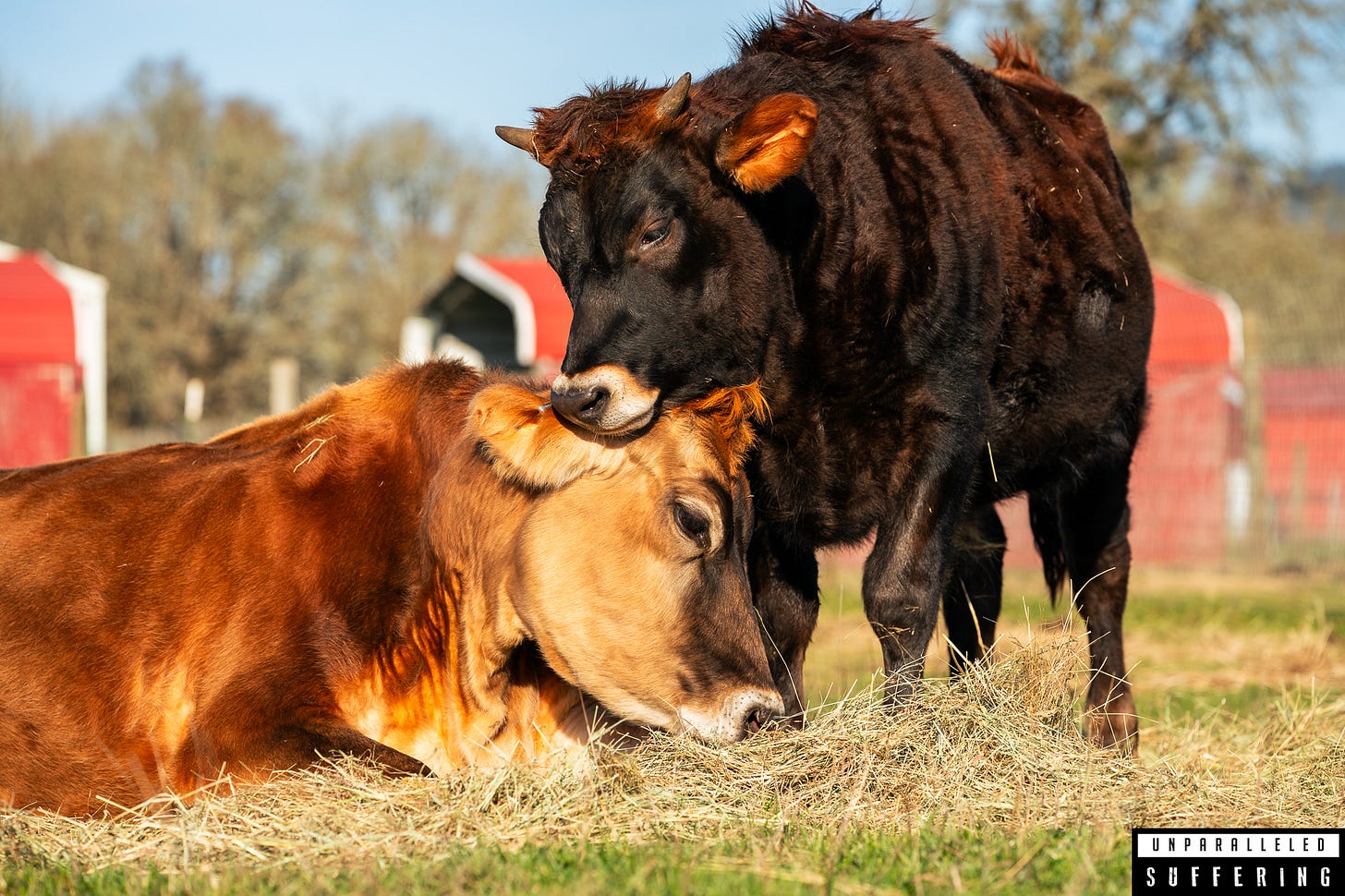
There are outlier dairy farms that do things a bit differently—they actually let their cows keep their babies for much longer than what’s standard in the industry. The first dairy farm I ever visited was one of these places. It was a small farm that actually lets the mothers keep their babies for the first two weeks of the calf’s life. Obviously if the mothers were such a threat to their babies like most dairy farmers state they are, this would be bad for business. One of the first things I noticed when I arrived at this farm was the non-stop and piercing bellows of this one particular cow who was clearly dealing with extreme stress. I already knew why, but I played dumb and asked the dairy owner why the cow was making those noises. He nonchalantly told me that it was because this cow’s calf had been taken to the livestock auction the previous day. Not only did this cow want her calf, but she was worried about them just like human and so many other nonhuman animal mothers would be.
I knew all the truth I ever needed to know about the dairy industry before I ever even started visiting dairy farms and witnessing dairy-related events such as pubic birthing exhibits and livestock judging shows, but now when I advocate against dairy I have more credibility to backup my claims and my antipathy towards the whole idea and tradition. However, no matter how much you’ve seen and taken in firsthand, animal exploiters will still tell you and anyone else who is against what they’re doing that you’re wrong, extreme, ignorant, uneducated, and simply don’t know what you’re talking about.
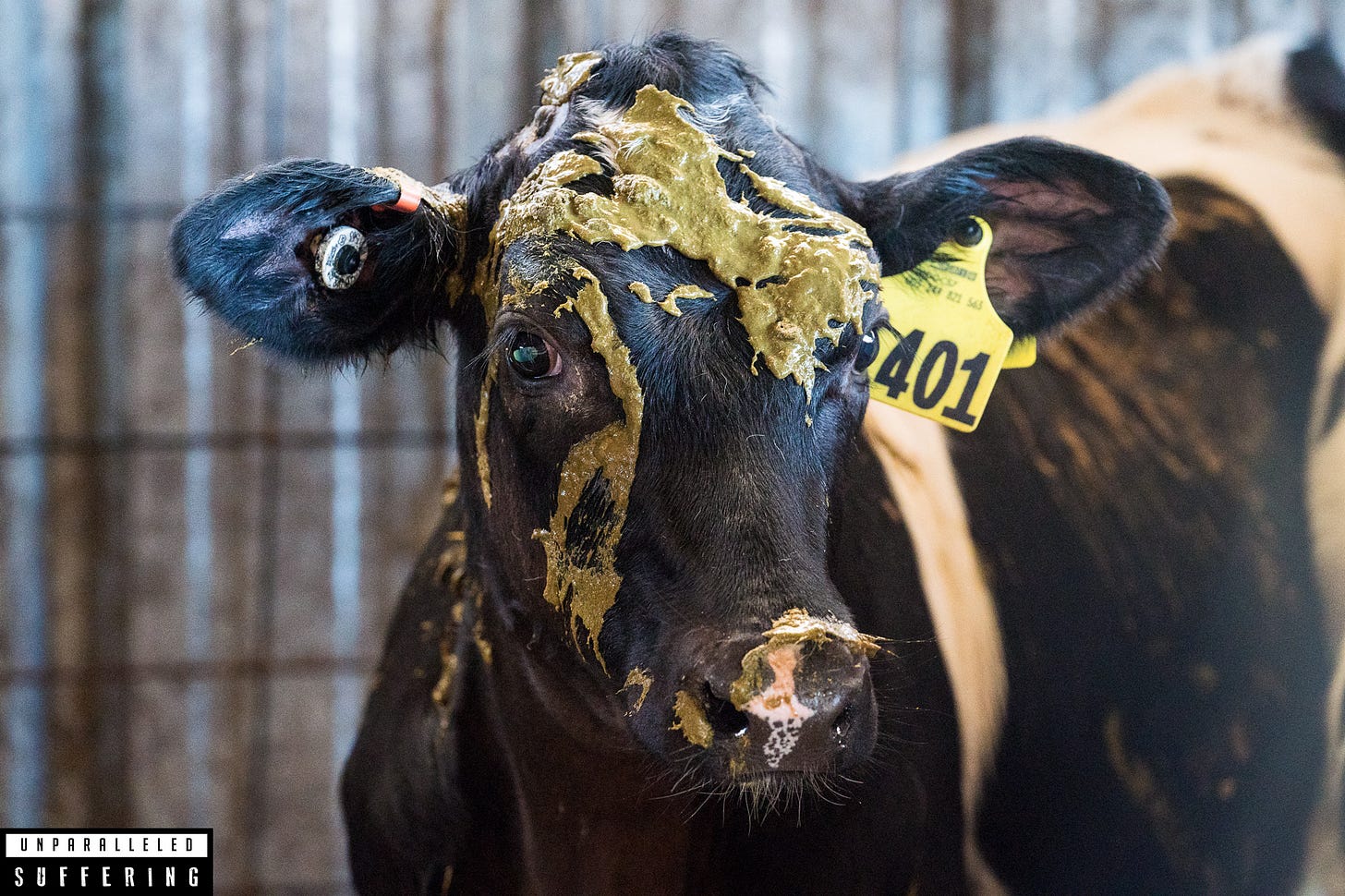
“Have you ever been to a dairy farm” and “You should actually visit a dairy farm” are comments they’ll use when people badmouth their vile industries. This is to imply that if you just get off your ass and actually go to an animal farm yourself you’ll see how wonderful they are and how they aren’t the mean places you’ve seen in photos, videos, and writings that all capture reality in an easy-to-understand and shareable way. You can’t actually know what you’re talking about because you’ve never even stepped foot onto a farm. With this logic I guess we also can’t assume that prisons, detention centers, homeless shelters, and concentration camps aren’t good places to have to exist since we’ve never visited them personally.
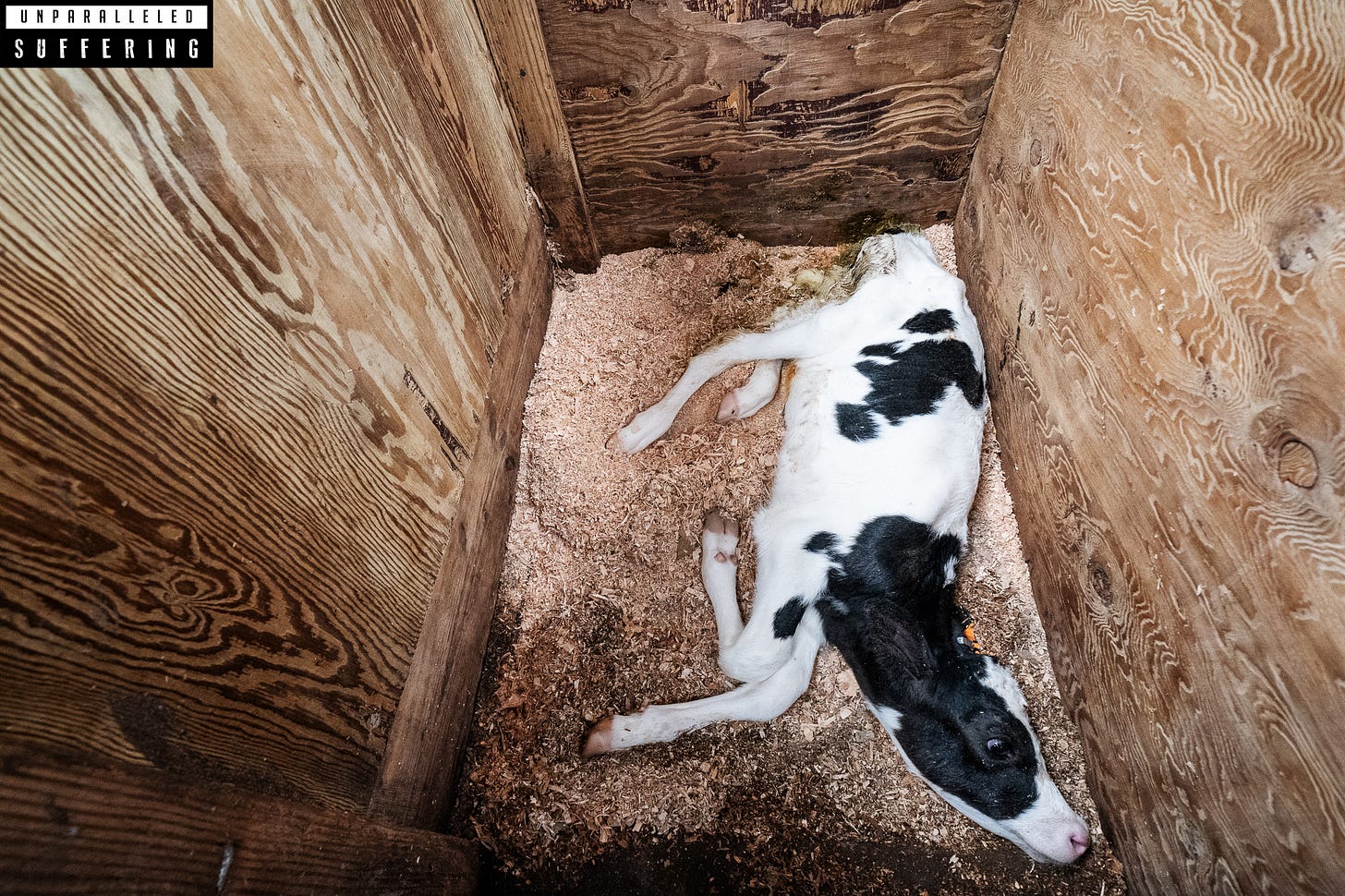
I’ve visited tons of farms, some with and some without permission, and I’ve never seen anything that has made me shift my perspective towards the goodness or wholesomeness of what these abusers are committing because there is absolutely nothing kind, necessary, or natural about what they do. In fact, visiting farms has only made me more sickened, angered, and outraged by what humans do to completely innocent animals who have no options except to take the abuse and try to adapt as best as one can. I don’t distinguish between so-called ‘factory farms’ and smaller operations, they’re all psychotically structured and depraved places of horror, suffering, violence, and ill will.
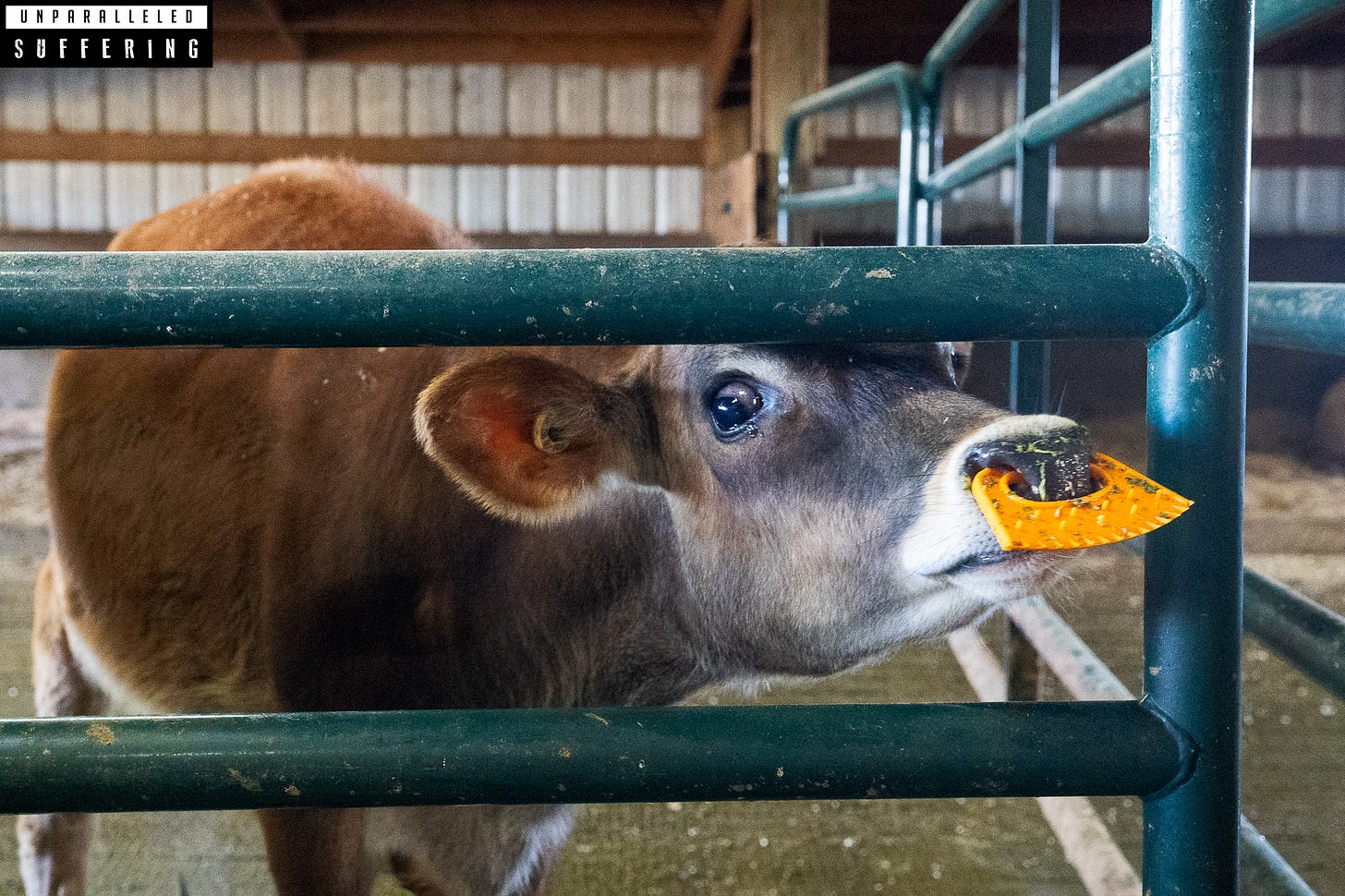
But whether I visit a farm or you visit a farm there are certain ‘regular’ things that we are never likely going to encounter because the farmers who want us to “see the truth” will always end up concealing the truth.
Keeping up with the previous theme, let’s take a dairy farm for example.
Cows used for dairy are kept continually impregnated so they can keep producing milk and more milk sources (babies, if they are born female). Very few dairy farms still use bulls to impregnate their cows, so they will order frozen semen that comes from bulls confined at semen collection centers. One of the main ways semen is extracted from bulls at these nightmarish facilities is through the practice of electro ejaculation (feel free to do your own research on this if you’d like). At the dairy farm, after thawing the semen and restraining a cow, a worker will place a semen straw inside of an AI (artificial insemination) gun and proceed to forcibly inseminate the cow. Just like everything else in the world of animal exploitation, apparently this can be done “humanely.”
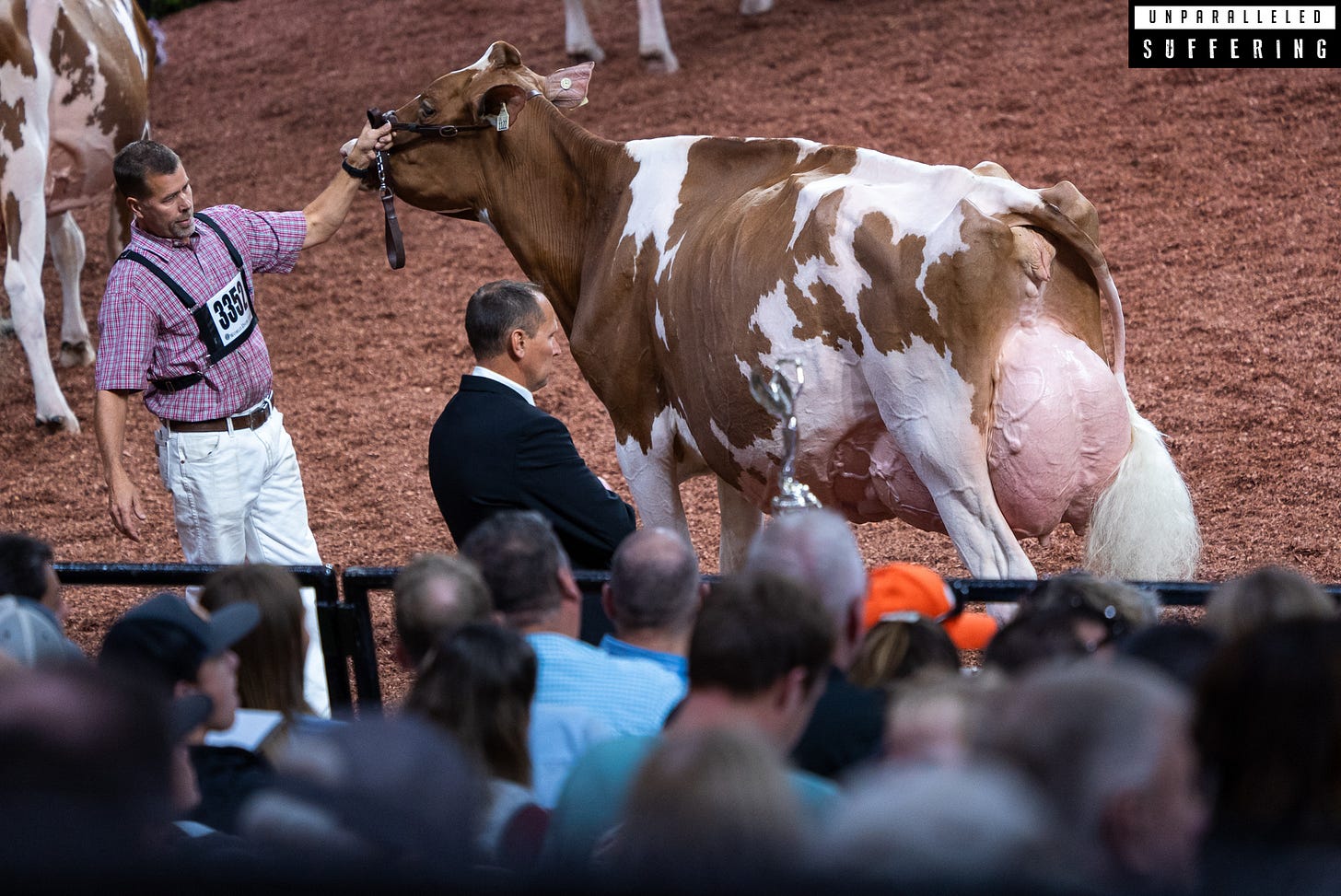
Artificial pregnancies are standard practice for every cow on the vast majority of dairy farms, but despite having visited many dairy farms myself I’ve never seen this process happen in person. I’ve witnessed this ugly practice plenty of times in videos and I think that’s more than sufficient to have an informed opinion (so is just knowing about it and never witnessing any such media). Making babies is the most integral part of every sector of animal agriculture, but don’t expect to ever encounter how this is done if you visit a farm.
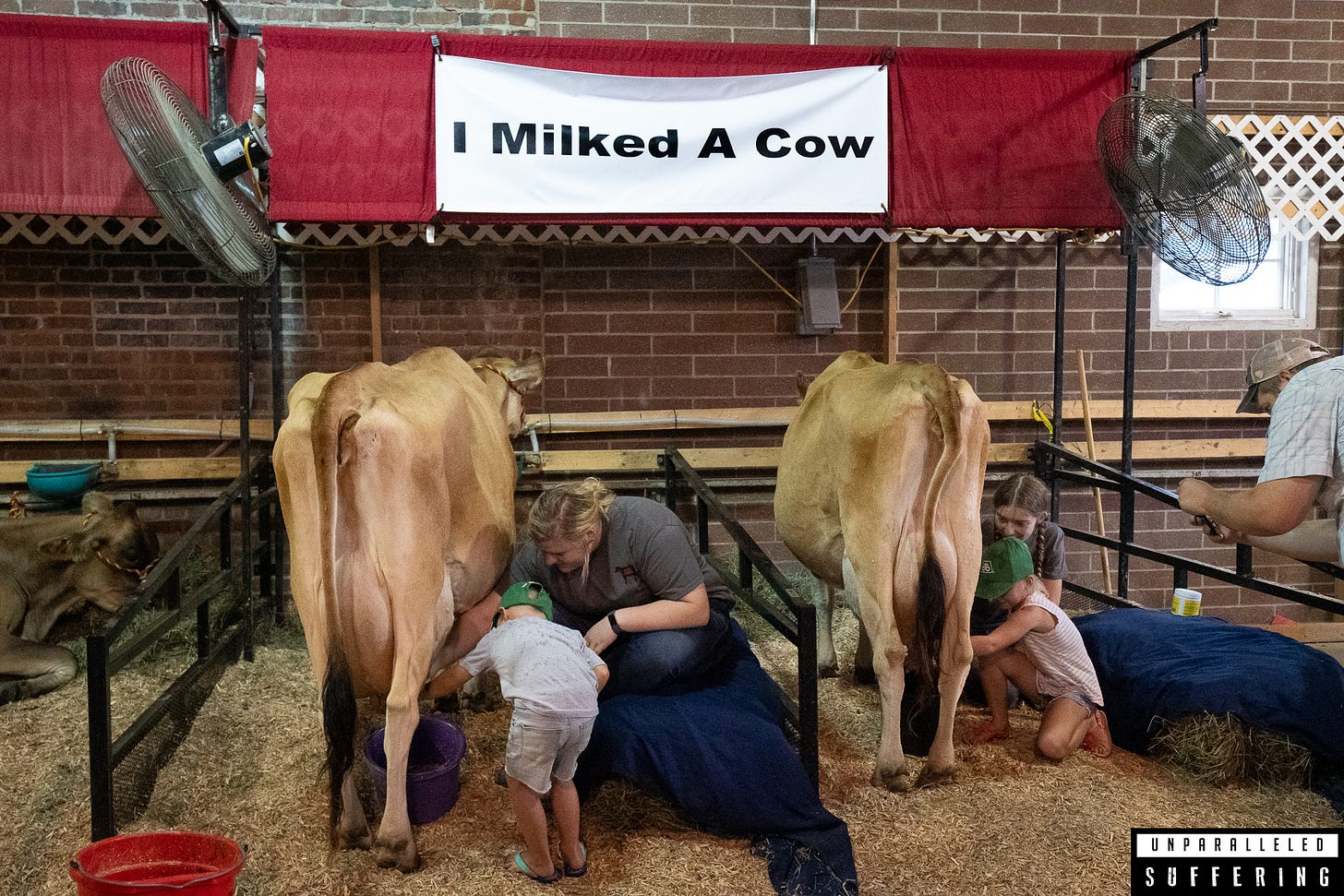
Boys born on most dairy farms are considered waste products since they’ll never produce a drop of milk. At certain farms the boys will become steers, so they’ll get castrated one day without any pain relief and live if they survive until they’re around 18-24 months old. A large percentage of boys born in the dairy industry will either be shot or beaten to death unless they starve or they’ll go to a livestock auction and be slaughtered extremely at a few days old (bob veal) or they’ll or get shipped off to a veal farm and be slaughtered at around 4-5 months. Of course as a visitor to a dairy farm you’re not going to be shown a male calf being killed and you’re almost definitely not going to get permission to visit a veal farm, which is technically part of the dairy industry—despite the fact that the people in the industry almost never want to acknowledge this unpalatable fact.
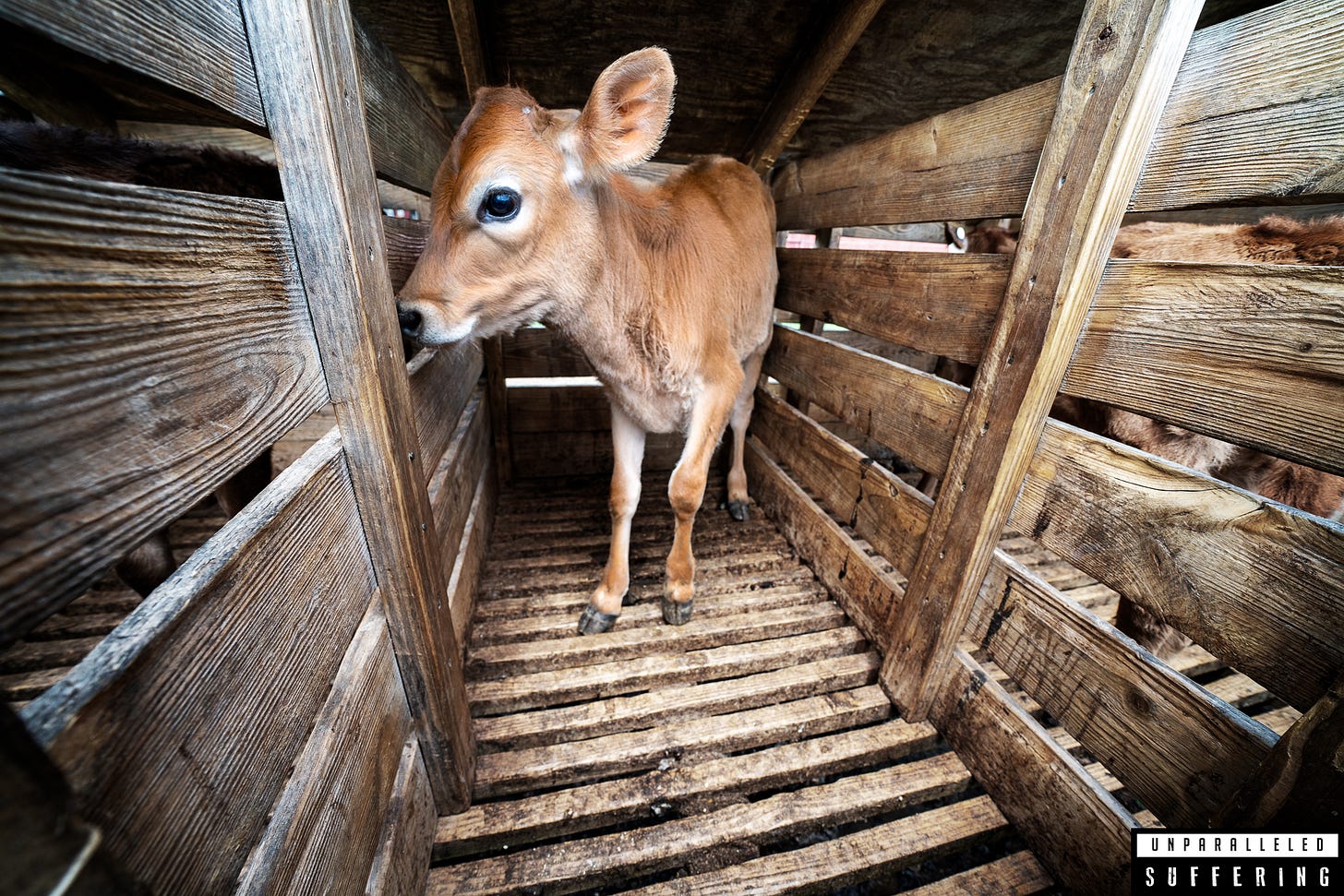
Horn removal is another brutal reality that’s standard practice on dairy farms and a practice you’d be unlikely to ever witness if you visited a farm. I’ve been to a couple small dairy farms where the cows were permitted to keep their natural horns, but the standard industry practice is to remove them. This is never done with pain prevention before the procedure or pain relief after the procedure. Calves and cows will have their horns removed in a variety of ways and at different points during their life cycle. Some of the methods include using a hot iron, caustic paste, and cutting them off with a saw. Even though I have never witnessed horn removal on a dairy farm I did have a very rare chance to witness this mutilation at a beef farm.
I still don’t know which part was worse, witnessing the suffering of the animals or the enjoyment of the humans. I watched as cows were restrained inside of a squeeze chute and had their horns sawed off, completely freaking out with terror in their eyes and extreme pain in their vocals and panicked movements. Blood would shoot out in long lines and a young boy who perceived this display of cruelty as fun would shout out “fireworks” as the blood spurted.
Cows on dairy farms all eventually go to a slaughterhouse, or at some operations they get slaughtered on the farm, if they don’t die first from something else. Despite the fact that cows can live well into their 20s, or in some cases even longer, most cows used for dairy will be put to death when they’re only 4-5 years old. At smaller dairy farms cows can sometimes live longer than the industry standard, which is not necessarily a good thing since it’s going to mean more pregnancies, loss, and grief. If you visit a dairy farm they’re probably not going to allow you to come out during the time in which they’ll be loading their cows onto the truck to go to slaughter, which normally involves humans yelling and inflicting extreme pain onto their bodies to force them to make their way up the ramp into the trailer.
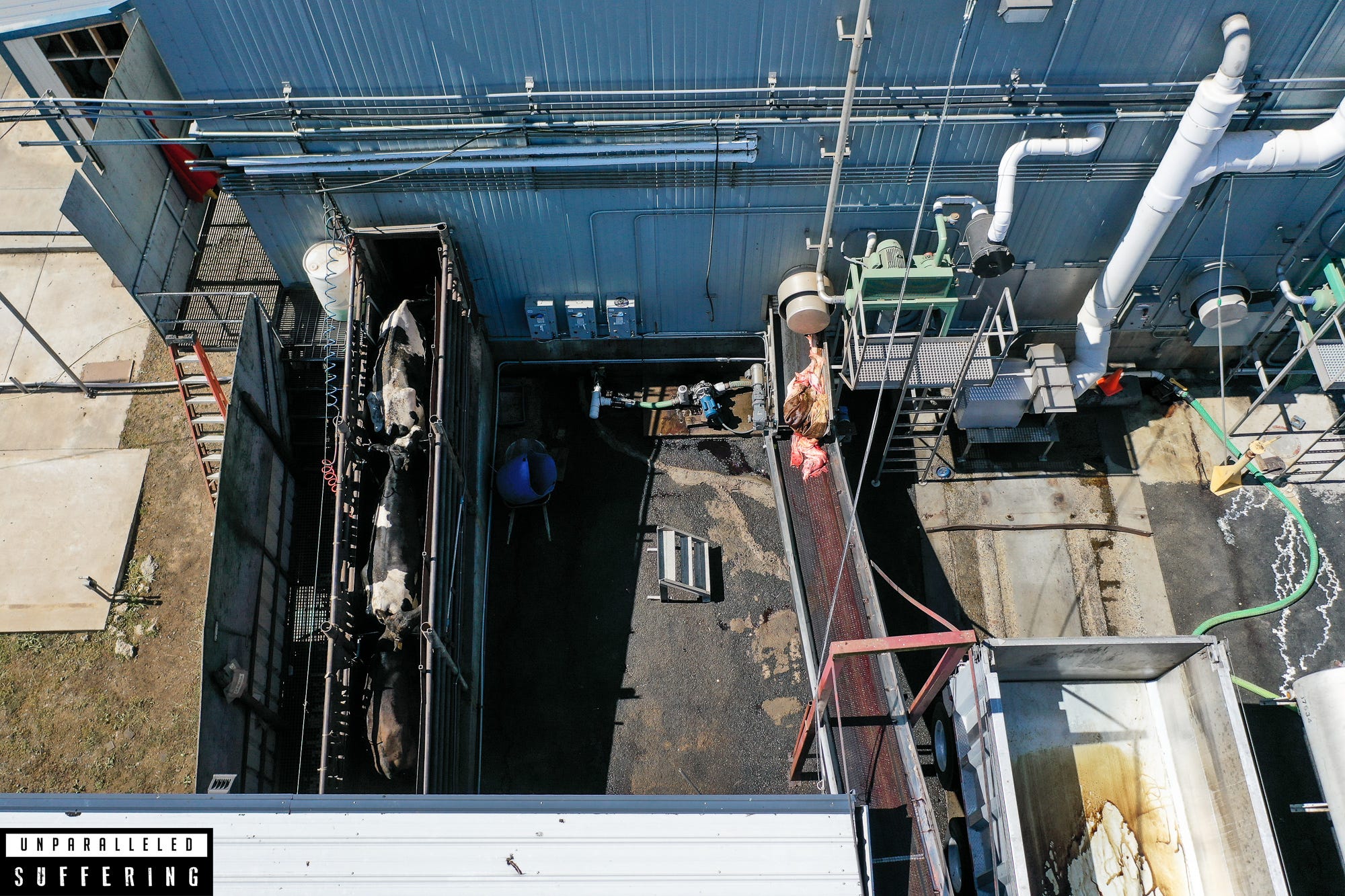
One time when I was permitted to visit an extremely large dairy farm the owner walked me around to different areas, but she refused to show me the building that housed all of the ‘damaged’ cows who were in there due to sickness and injuries. As much as I wanted to see this area of the facility I knew there was no talking her into letting me see it. At a small dairy farm I visited not too long after this big dairy the owner wouldn’t let me walk up towards the part of the barn that kept the cows with mastitis, an extremely common and painful infection of the udders that cows used for dairy experience from the constant artificial milking. Had I not been holding a camera, maybe she wouldn’t have minded me being near those cows suffering with mastitis, but she didn’t want to chance me getting a photo of the reality of dairy that could “be used in the wrong way.”
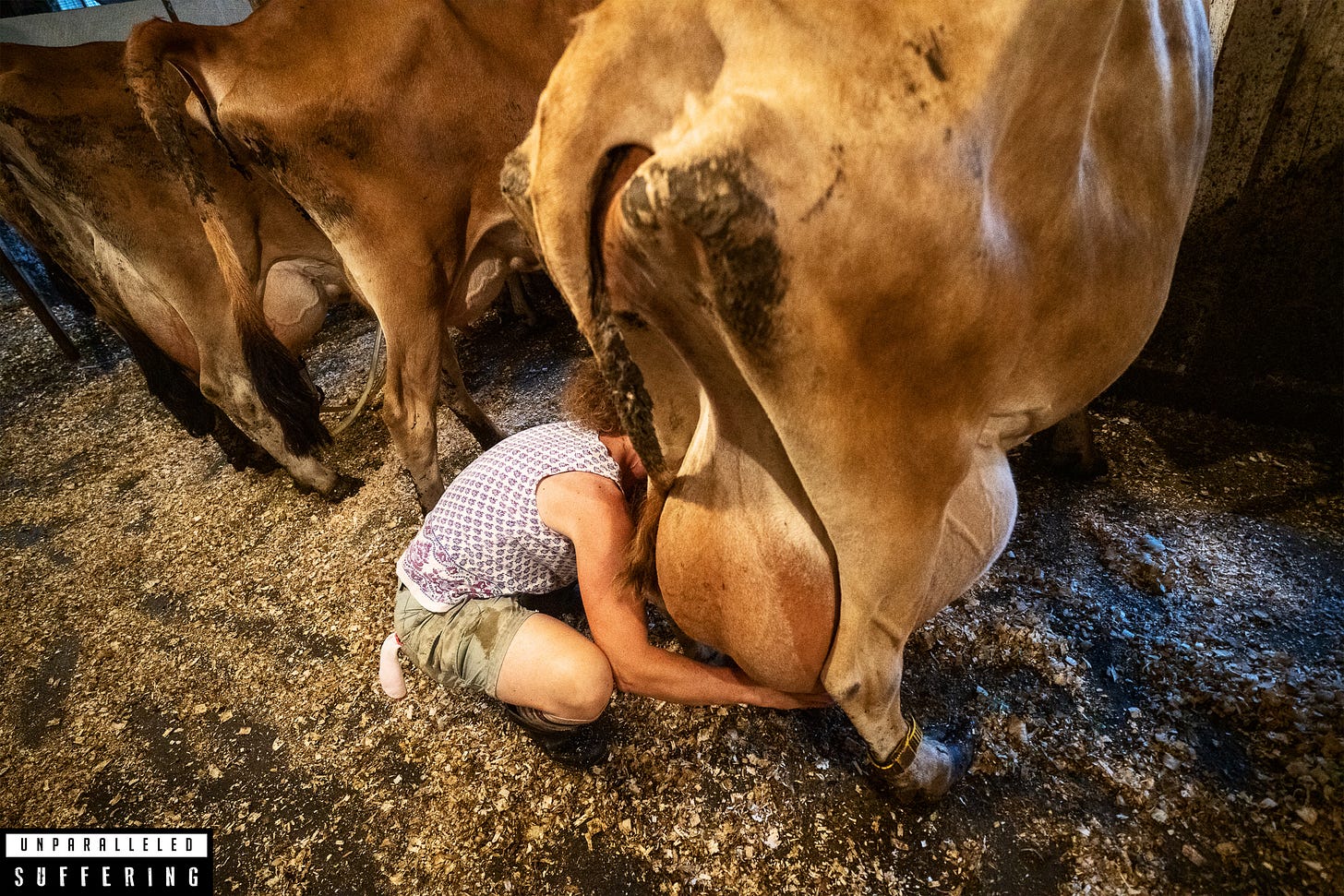
At the most recent dairy farm I visited, about a month ago, I went into the farm store and asked the man at the counter if I could walk around and take photos. Without hesitation he gave me the bright green light. Despite being granted permission, I still had to abstain from photographing everything I wanted to capture.

When it was time to milk the cows two young girls herded all the cows into the barn with far more aggression than I had anticipated. Although they knew that I was a stranger with a camera, they proceeded to violently punch, kick, push, and poke a bunch of the cows to hurry them up and get them into the exact spots they wanted the cows to be in for milking. This scene persisted for quite a while, yet I didn’t take a single shot of the abuse precisely because I was trying to keep the inevitable suspicions as low as I possibly could.
Fast forward to a little while later and I was getting the sense that the suspicions were growing even though the workers didn’t voice anything of the sort to me. I saw them texting on their phones and was wondering if it could be about me. Then a little bit later I saw a man come in and walk through the barn. I got a feeling that he was suspicious, but several minutes went by and he hadn’t come back to the area of the barn I was in and he disappeared outside of the barn after hanging in the back for a bit. Then out of nowhere while I was filming a cow getting milked he came up behind me and asked me if I was an animal activist. I am used to animal exploiters asking me if I was with PETA, but not a more general animal activist.
There’s a myth that I almost can’t believe still exists in which people think that if you ask someone who you suspect might be an undercover cop if they are an undercover cop they are legally required to expose themselves if they do happen to be a police officer. This has never been the case; an undercover cop has no responsibility to inform anyone he’s with law enforcement if questioned. Well animal exploiters seem to believe their own version of this myth, that if they ask you if you are with PETA or if you are an animal activist you must forego your cover and expose yourself. I have never worked for PETA, so whenever I’ve said no to being associated with them I’ve told the truth. But of course I had to tell a white lie about not being an animal activist.
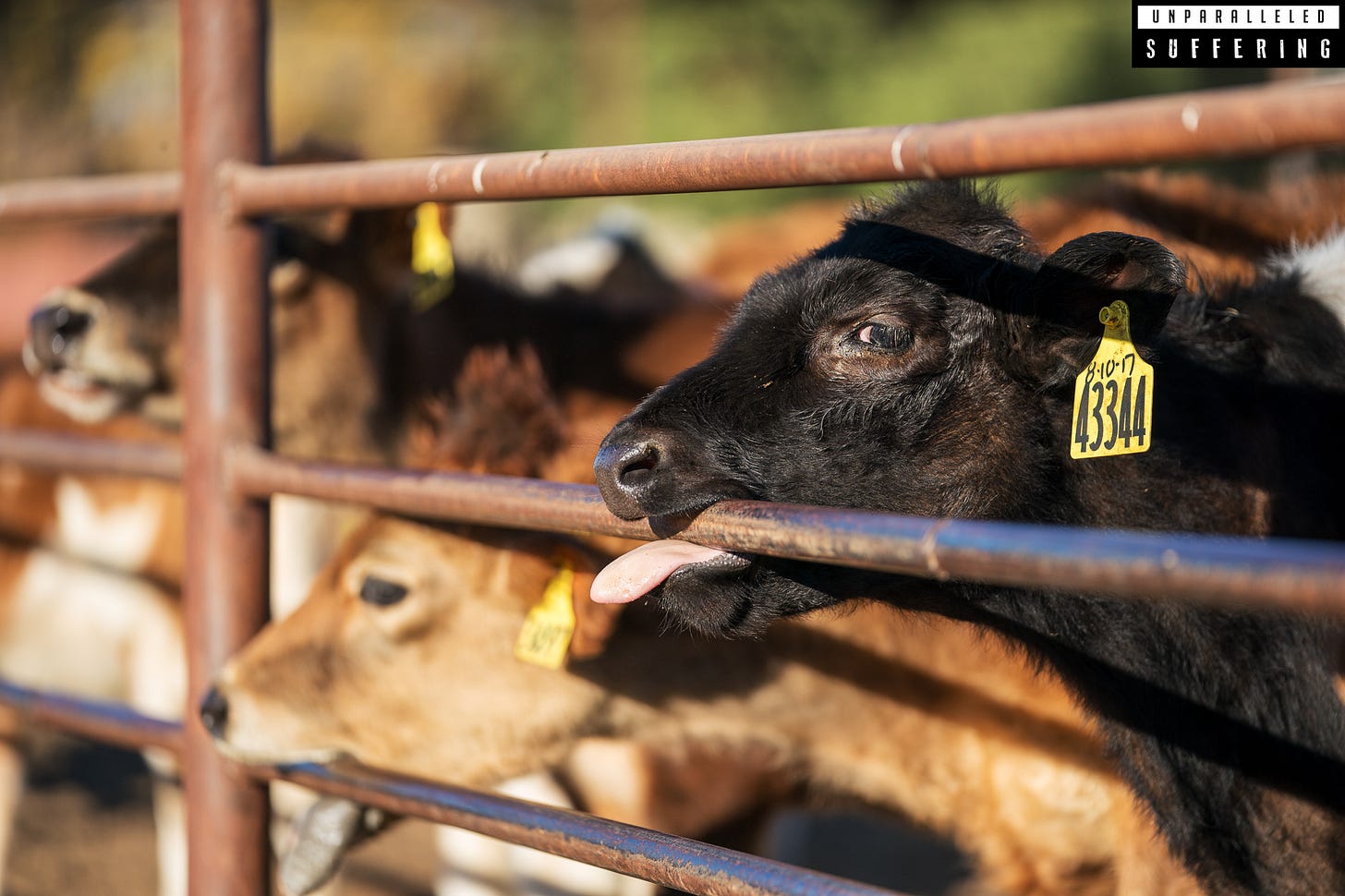
The most recent farm where I was questioned is almost always open to visitors. It’s viewed as the cream of the crop when it comes to animal husbandry. But unsurprisingly there’s so much cruelty on public display…such as the calves, who are inherently very social and playful animals, all in their own hutches deprived of socialization and play. I watched as the calves who are unable to satisfy their suckling instincts biting and suckling on the bars that make up the the front of their hutches. Frustrated mother cows swarmed by and a base to a relentless army of flies day after day. The ability of mothers and calves to view each other from afar and call out to each other, but not to be with each other. The pain of swollen udders that hang down towards the ground carrying vastly more milk than cows would naturally produce. Daily bellows of grief that disturb what would otherwise be a fairly peaceful area.
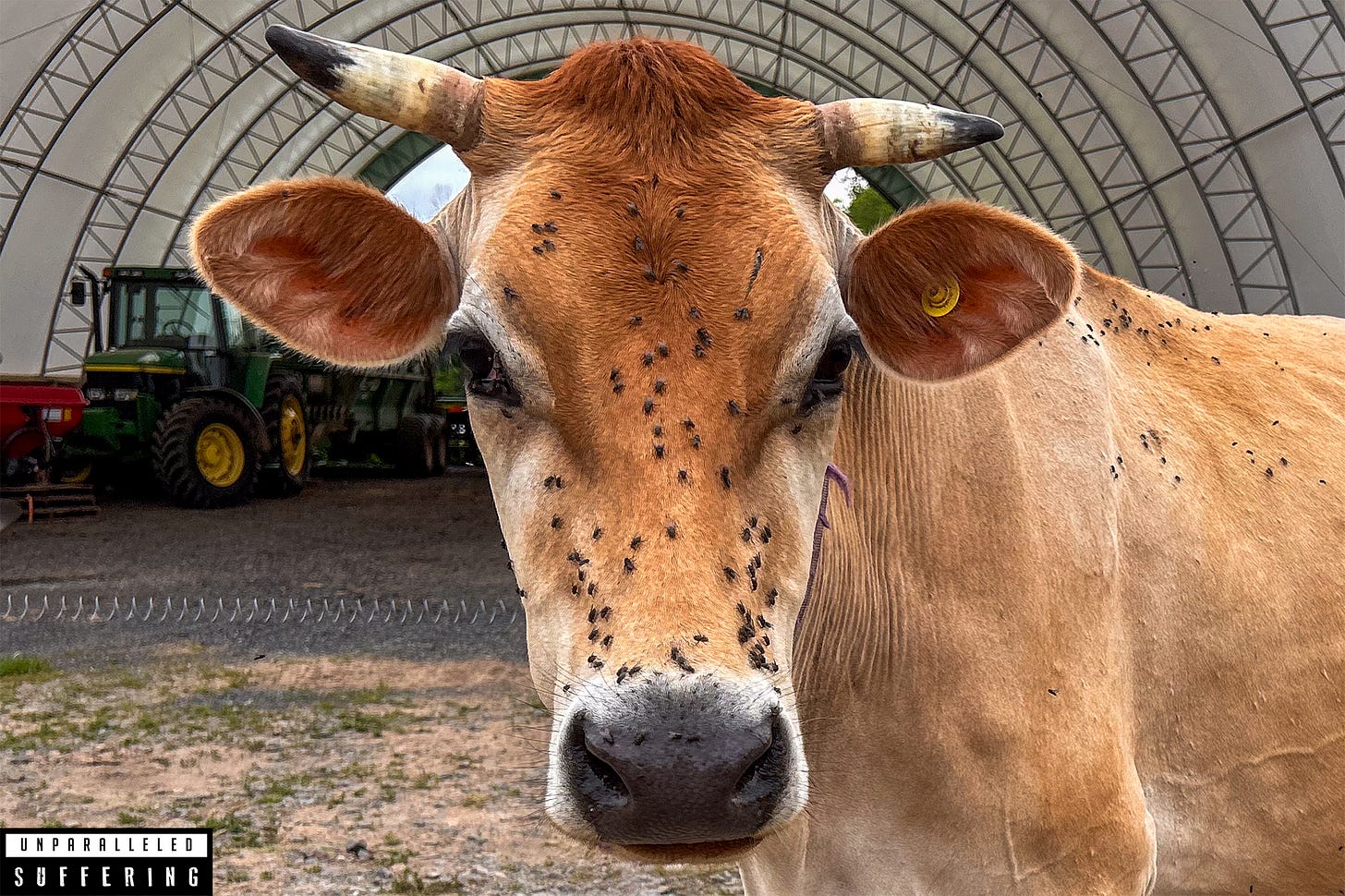
The only farms I’ve ever stepped foot on where animals are genuinely treated humanely and get to experience a life worth living is at farmed animal sanctuaries. Most legit sanctuaries are open to visitors and the owners won’t go out of their way to conceal anything. At these places families and friends stay together, nobody has their semen collected or their vagina penetrated, and animals get to live way past what their lifespan would be in an exploitation setting. The individuals are in a safe, protective, nourishing, caring, kindness-filled environment that allows their personalities to bloom and their emotions to experience the best psychological states available to all of us.

The question shouldn’t be “have you ever even been to a farm,” the question should be “have you ever even been to a farmed animal sanctuary?” In other words, have you ever seen what’s possible, or have you ever seen the radically different way that we can treat these animals—a way that doesn’t automatically deal them a lifetime of trauma, misery, suffering, and unimaginable pain. Because this is the way farmed animals could live, should live, and deserve to live—if they are already in existence.
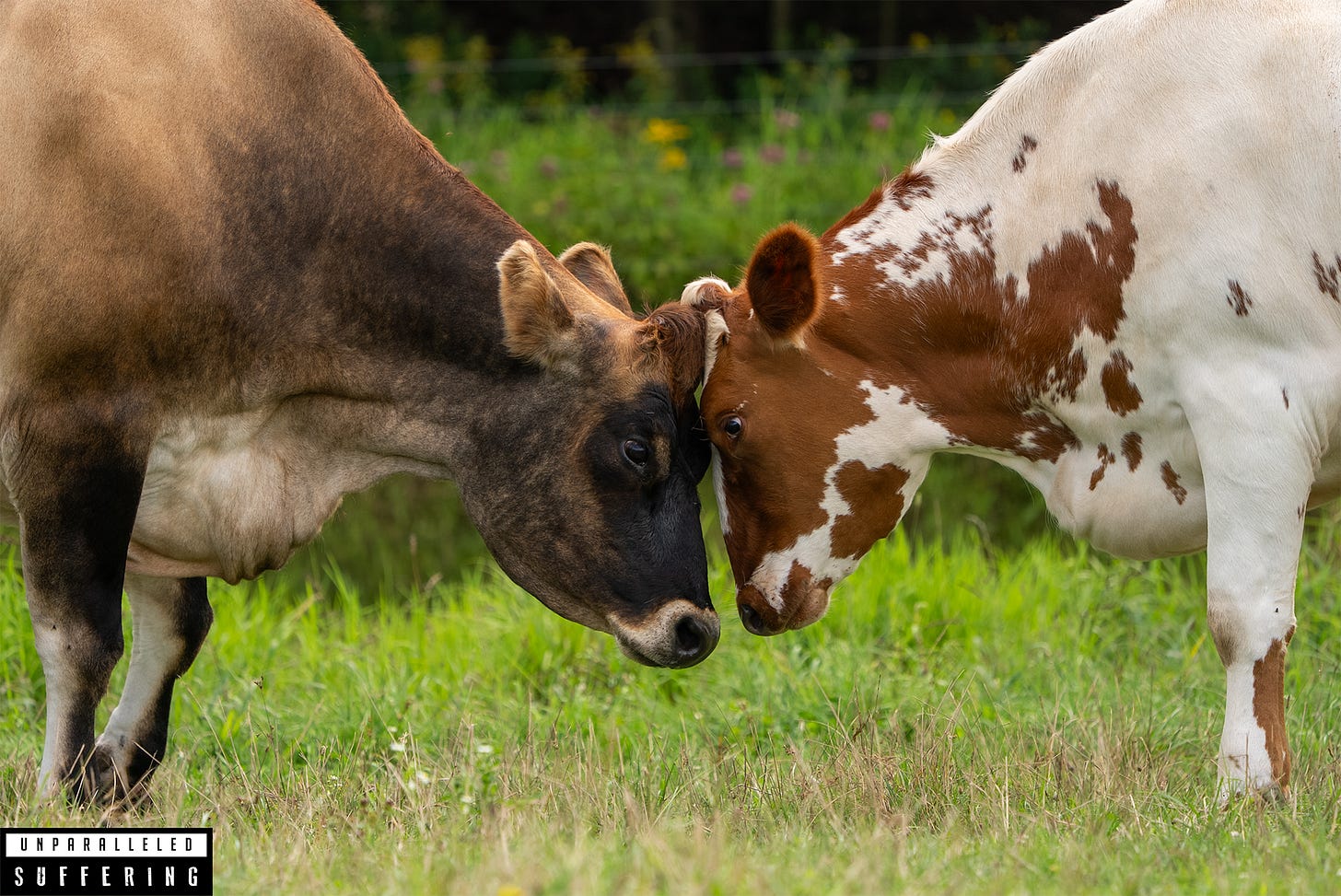
And sadly far too many people are unaware of this type of relationship with and environment for animals. Even worse, way too many people are not even curious to explore this much evolved and just form of cohabitating with other life. We have ethical alternatives to nearly everything and we owe the golden rule to others who happened to be born inside the bodies of other species. The ethical alternative to animal exploitation farms isn’t a better exploitation farm that’s a little less mean or violent or degrading, the ethical alternative is a farm that doesn’t exploit animals in the first place, but rather provides them with love, care, compassion, and the ability to thrive and live in the type of peace that we all wish for ourselves.
.






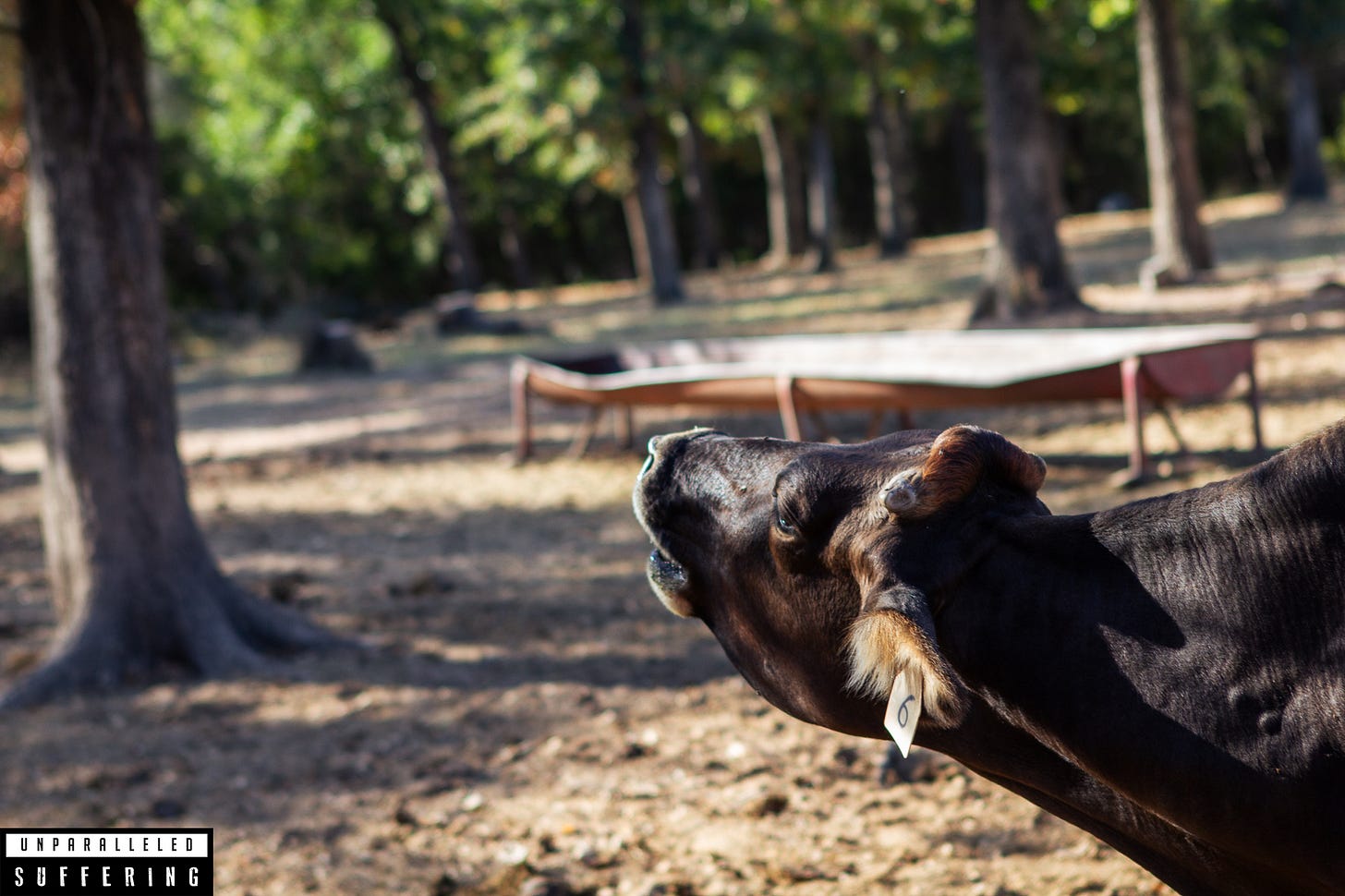
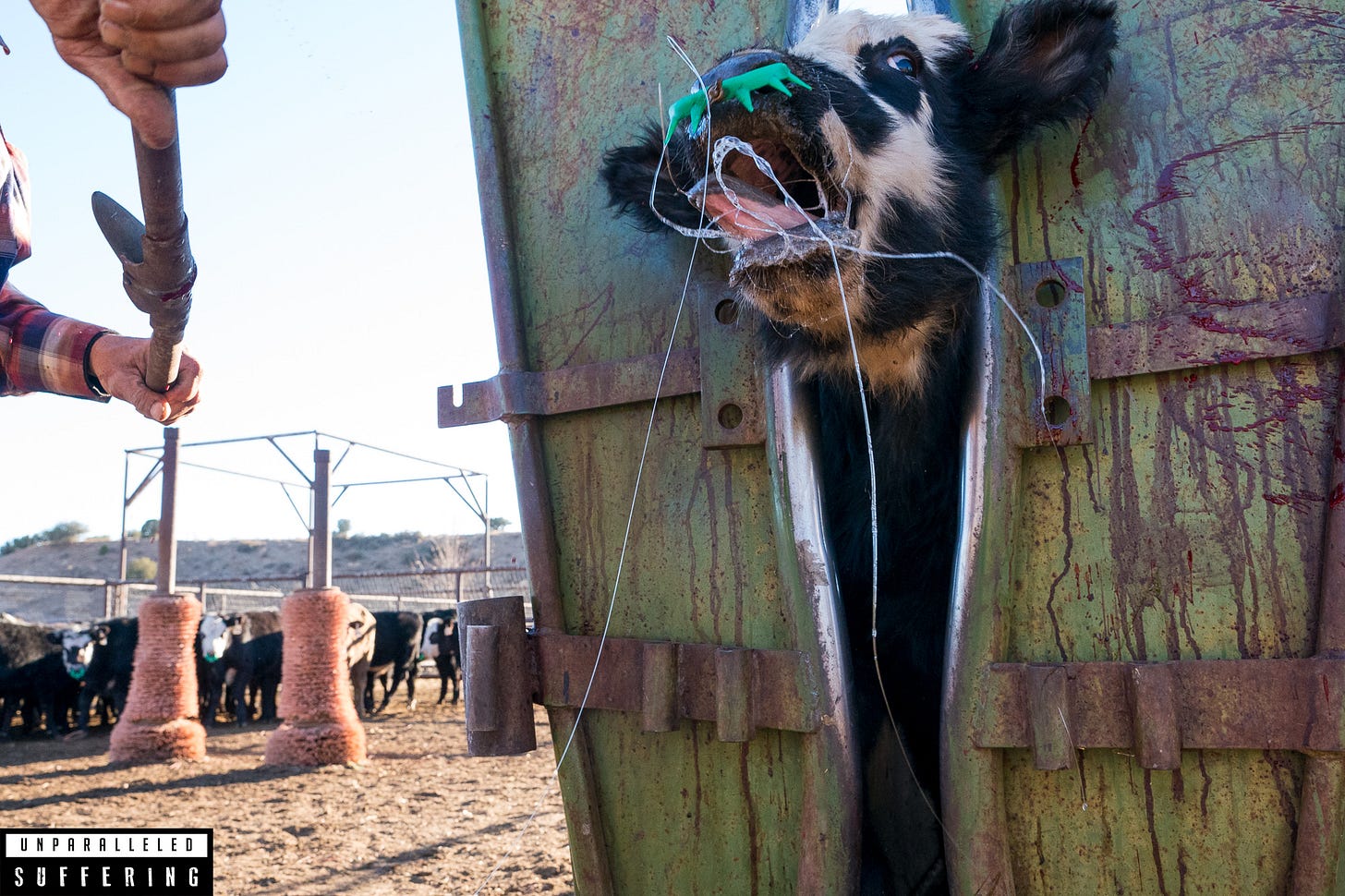
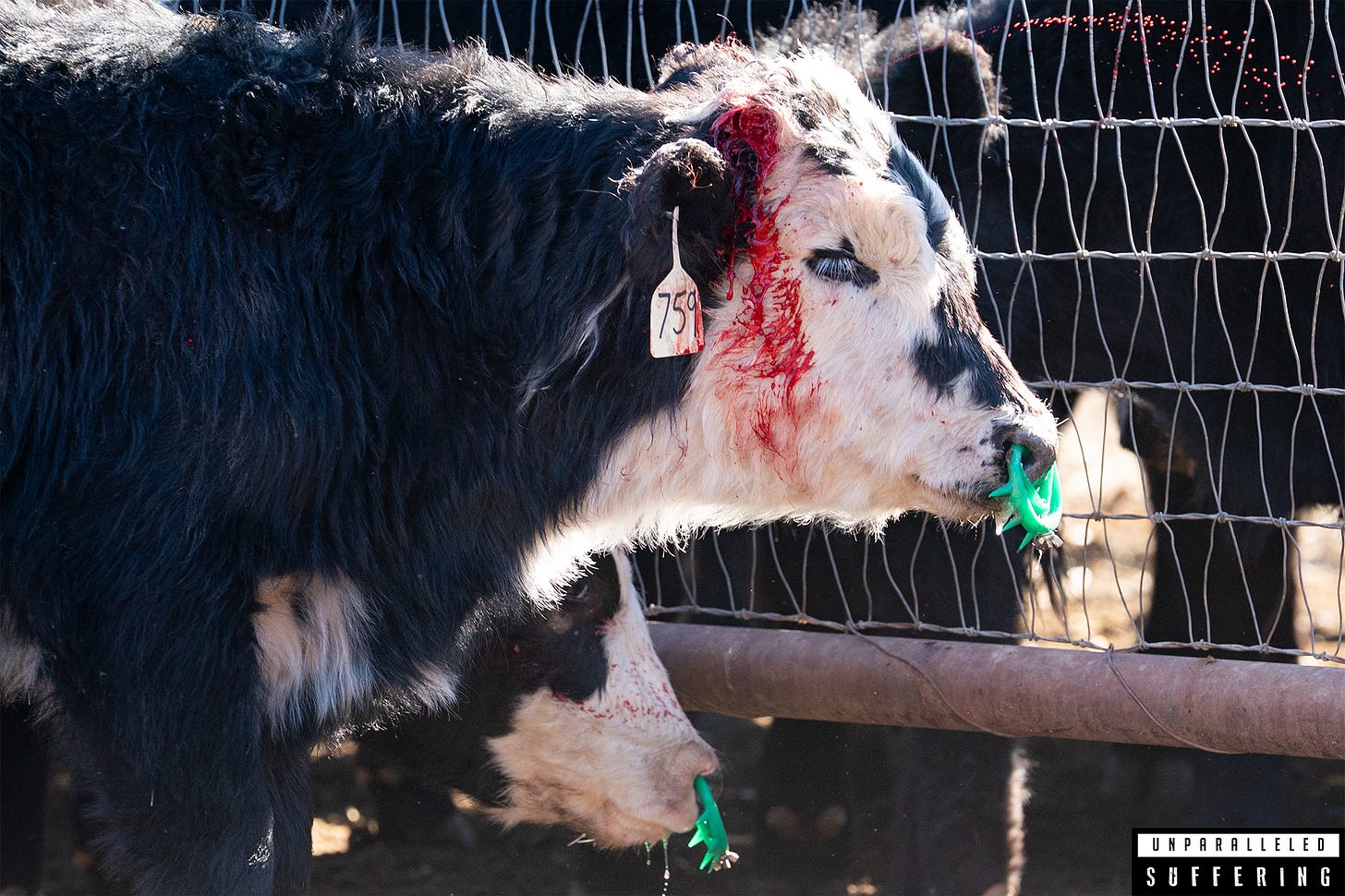
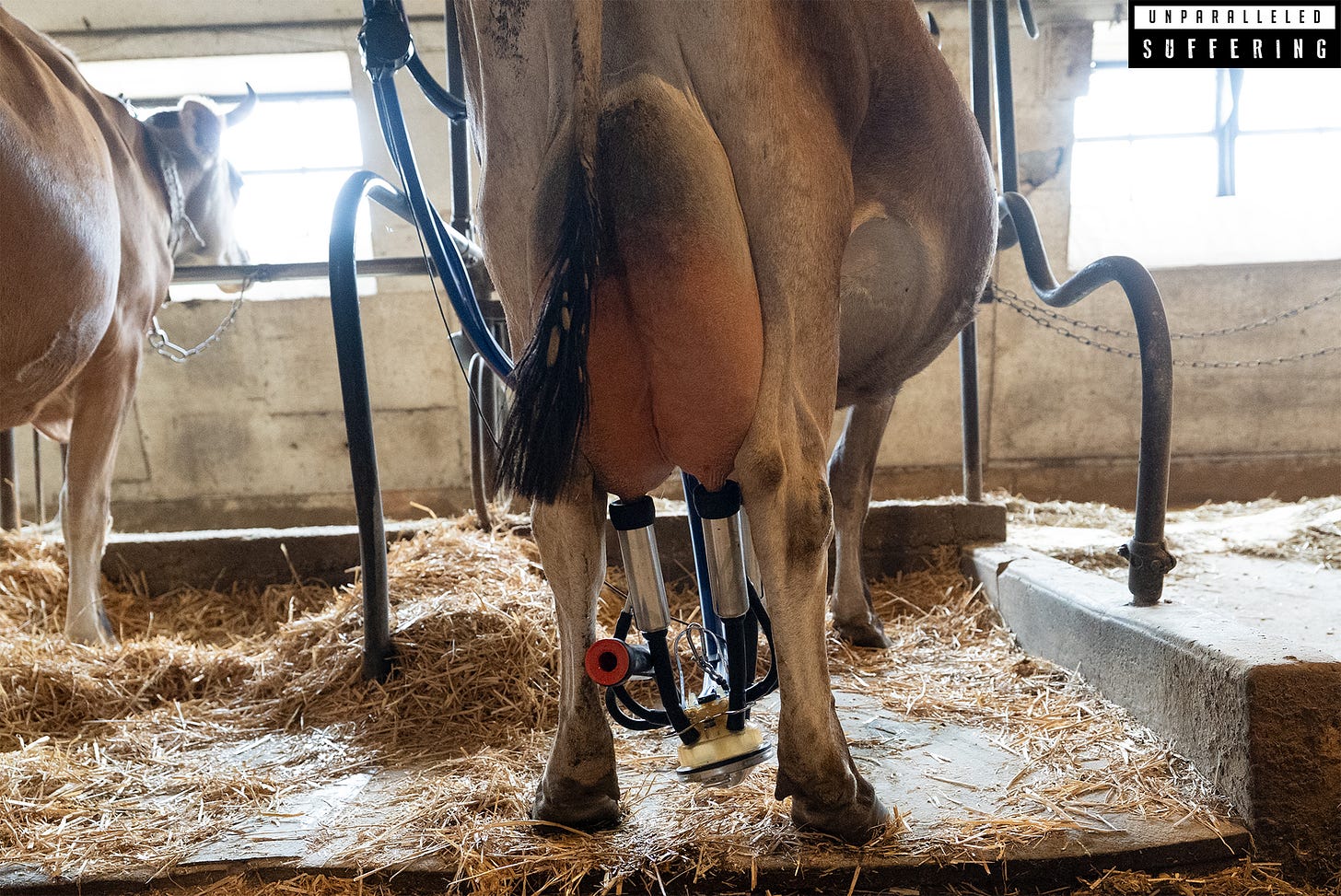
“It is a healthy, natural reaction for someone who witnesses the brutalities inflicted upon nonhuman animals in the agriculture industry for the first time, to ask, "how can we stop this from happening?”. The simple truth is that there remains only one answer, only one way to stop it from happening. We must end the consumption of animal-based products. Until then, nonhuman animals will always be placed in "livestock" conditions, they will always be exploited, they will always be abused and they will always be slaughtered. You cannot teach someone that a life-form has any real value when it is considered acceptable to enslave, kill and eat said being. Whilst humanity views nonhuman animals as resources, mere commodities, they will always be victims of our barbarity. There is no "humane" way to treat a slave and there certainly is no "humane" procedure to take a life.”
Excellent observations and commentary, Unparalleled Suffering. Thank you very much for your courageous activism.
Cows and other farmed animals are made to suffer in so many ways. This has been exhaustively documented time and again, and around the world. One would be so naive to think that there is anything humane about flesh, milk or egg production, and why ever would anyone believe those who profit from it?
There are so many delicious, affordable vegan alternatives that are widely available and better for us, too (and for the environment). It's high time the public wake up to the realities of animal agriculture and stop supporting this egregious animal abuse. High time for the government to stop subsidizing it, too.